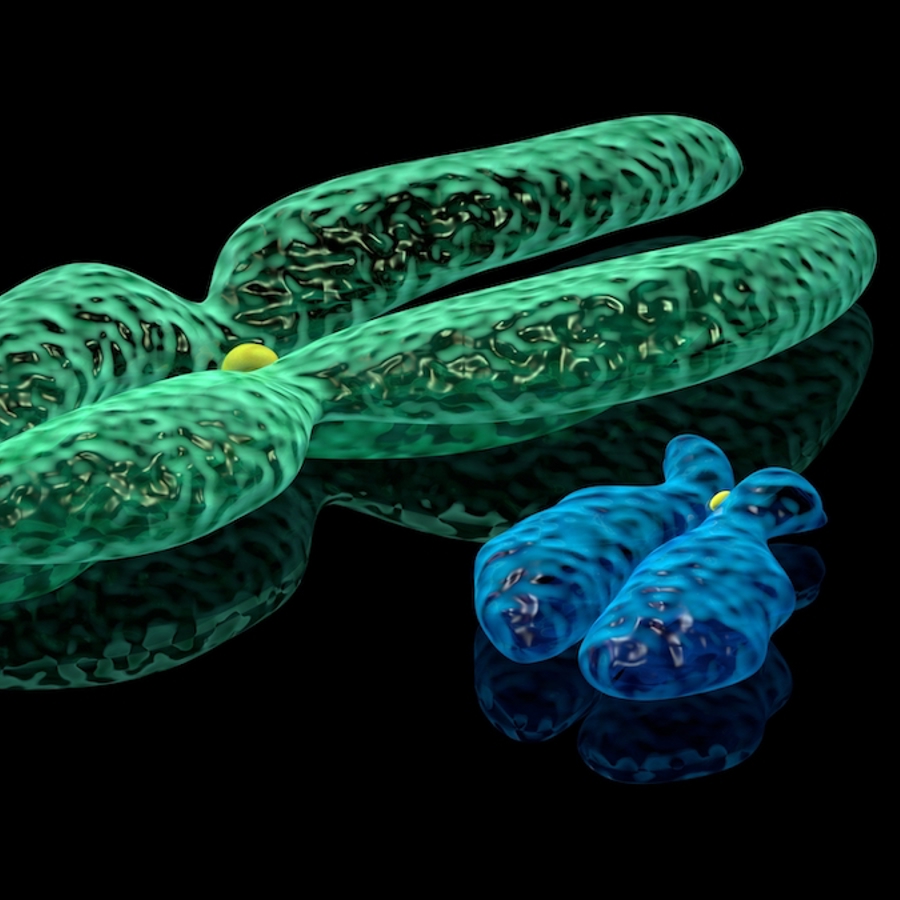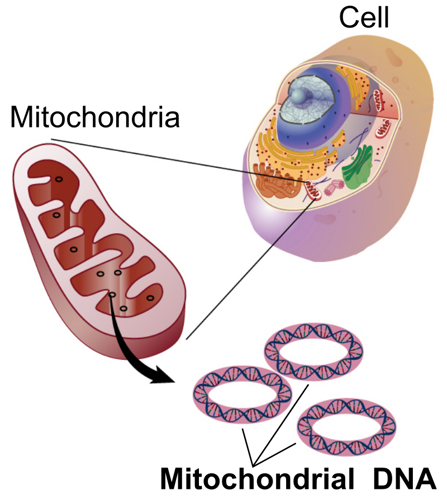
Does the Y chromosome change from generation to generation?
January 7, 2009

- Related Topics:
- Genetic sex,
- Y chromosome,
- Chromosomes,
- Recombination
A curious adult from Texas asks:
For something so tiny, the Y chromosome is fascinating in a lot of ways. It is passed virtually unchanged from father to son (women do not have this chromosome).
This means that certain traits are indeed passed only from father to son through the Y chromosome. But this isn't as significant as it sounds.
The Y chromosome is a puny bit of DNA that has only a few genes. And the genes it does have mostly deal with being male. So the only traits that are passed from father to son through the Y are those that turn an embryo into a male and those that make a man fertile once he reaches puberty.
Note that I said that the Y passes from father to son virtually unchanged. It does change a little from generation to generation, even picking up a bit of mom's DNA along the way. It just doesn't change as much as most of our other chromosomes.
Your Unique Set of Chromosomes
We have 23 pairs of chromosomes – 22 pairs of autosomes and one pair of sex chromosomes. The sex chromosomes are the X and the Y. Most people with two X chromosomes identify as female. And most people with an X and a Y chromosome identify as male. In eggs and sperm, there is only one of each pair of autosomes and one of the sex chromosomes.
The cool thing is that your mom's body didn't just pick one of the two chromosomes in the pair to go into the egg – it made a unique one just for you! The two chromosomes of each pair swap some DNA in a process called recombination. This gives you a one-of-a-kind chromosome and also helps to fix any damaged genes. The same thing happens in making sperm.
So we know that this happens for all of the chromosomes that have pairs. This includes any of the 22 pairs of autosomes, regardless of gender. And if you have two X chromosomes, they will recombine, too. But what if you have an X and a Y chromosome? Do these chromosomes recombine? They do, but just a little.


The Y Chromosome Recombines with the X and Itself
To understand how DNA swapping works for the X and Y, we need to go back around 300 million years. Back then we all had two X chromosomes and there was no Y.
At some point, a DNA change happened in one of the pair, creating the SRY gene. This is the gene on the Y chromosome that gets the ball rolling in turning an embryo into a male. Shortly after this happened, the X and the Y chromosomes stopped recombining with each other to keep the new SRY gene from changing.
Over time, the Y has lost many of its genes and shrunk down to the tiny chromosome that we know today. Part of the reason this happened is that most of the Y had nothing to recombine with.
Around 5% of the Y chromosome matches pretty well with the X and can recombine there. But the Y also needs to recombine with something for the other 95% of the chromosome. Otherwise it might completely disappear! (Like in the transcaucasion mole vole.)
Luckily, our Y has found a partner to recombine with. Itself!
The Y chromosome has a second copy of its most important genes within itself. These copies are mirror images, or palindromes, that read the same way forwards and backwards (like the sentence “Madam, I'm Adam”). The Y swaps pieces of DNA between these genes.
This second copy is useful because it means the Y chromosome can go through recombination with itself to fix any errors and to make a unique new Y to pass along. So men pass along a Y chromosome to their son that is similar, but not exactly the same, as his own.
But these aren’t the only changes that happen to the Y chromosome. Because its recombination isn't as good as the “normal” kind, the Y tends to pick up extra DNA changes. And these can then be passed onto a man's sons.


The Y Chromosome Picks Up Extra Changes Between Generations
When DNA is copied to make a new cell, the copying machinery sometimes makes mistakes. Our cells have excellent repair machinery that catches most of these. And almost anything that is missed can be fixed with recombination.
But the Y chromosome is a little different. These mistakes aren't fixed as well with its form of recombination. And so more mistakes can make it through. This means that a son's Y will have a few differences compared to his dad's.
So dad's Y chromosome is passed to his son with a few differences. A bit of recombination with the X, some recombination with itself, and a few uncaught errors makes for a slightly different Y.
The Y chromosome actually isn't the only DNA in our cells like this. There is another bit of DNA that passes from mother to children virtually unchanged for many of the same reasons. This DNA is called mitochondrial DNA.
Mitochondrial DNA Comes Only From Mom
Most of your DNA is found in a special compartment in your cells called the nucleus. This is where you can find your 23 pairs of chromosomes. But not all of your DNA is in the nucleus.
A tiny bit of your DNA is found outside of the nucleus in the little energy producing powerhouse in your cells, the mitochondria. Your mitochondrial DNA (mtDNA) came only from your mom – your dad's was lost right after your mom's egg was fertilized. How did that happen?

When sperm fertilizes an egg, all of its DNA and other stuff are transferred to the egg. This means the egg has its own mitochondria, plus the mitochondria from inside the sperm.
But the egg is so much bigger so it needs more energy. This means the egg has a lot more mitochondria compared to the sperm. So there are many fewer mitochondria from dad.
The egg also makes sure that the mitochondria from the sperm get marked for destruction. This ensures that the only mtDNA that gets passed along is from your mother. It passes virtually unchanged from mom to her sons AND daughters.
It is still being debated whether mtDNA goes through recombination. Since it doesn't recombine much at all, it can't fix mistakes very well. So mistakes build up faster here than in the chromosomes. Scientists use mtDNA to track ancestry through many generations!
It's pretty neat that only mom gets to pass along her mtDNA to her children. But dad is not left out. He gets to pass along a Y chromosome only to his sons – with just a tiny bit of modifications!

 Skip Navigation
Skip Navigation
